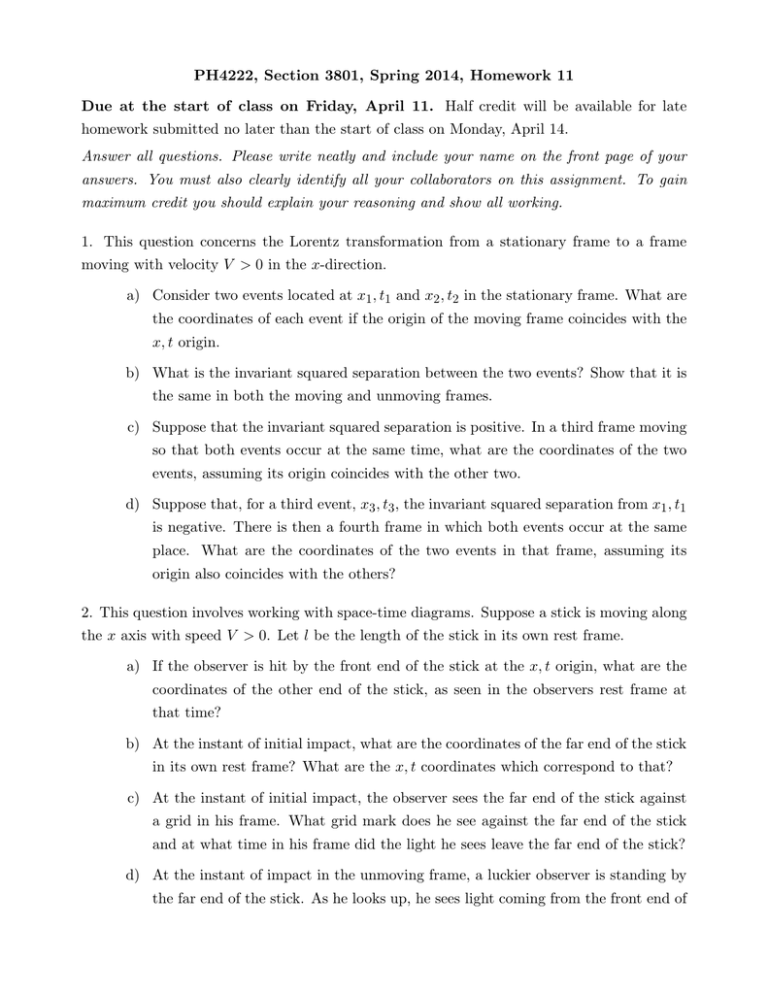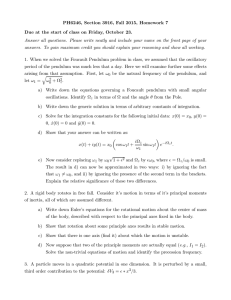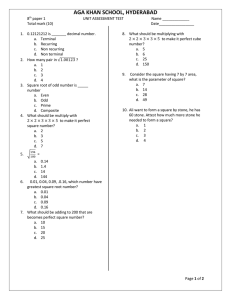PH4222, Section 3801, Spring 2014, Homework 11
advertisement

PH4222, Section 3801, Spring 2014, Homework 11 Due at the start of class on Friday, April 11. Half credit will be available for late homework submitted no later than the start of class on Monday, April 14. Answer all questions. Please write neatly and include your name on the front page of your answers. You must also clearly identify all your collaborators on this assignment. To gain maximum credit you should explain your reasoning and show all working. 1. This question concerns the Lorentz transformation from a stationary frame to a frame moving with velocity V > 0 in the x-direction. a) Consider two events located at x1 , t1 and x2 , t2 in the stationary frame. What are the coordinates of each event if the origin of the moving frame coincides with the x, t origin. b) What is the invariant squared separation between the two events? Show that it is the same in both the moving and unmoving frames. c) Suppose that the invariant squared separation is positive. In a third frame moving so that both events occur at the same time, what are the coordinates of the two events, assuming its origin coincides with the other two. d) Suppose that, for a third event, x3 , t3 , the invariant squared separation from x1 , t1 is negative. There is then a fourth frame in which both events occur at the same place. What are the coordinates of the two events in that frame, assuming its origin also coincides with the others? 2. This question involves working with space-time diagrams. Suppose a stick is moving along the x axis with speed V > 0. Let l be the length of the stick in its own rest frame. a) If the observer is hit by the front end of the stick at the x, t origin, what are the coordinates of the other end of the stick, as seen in the observers rest frame at that time? b) At the instant of initial impact, what are the coordinates of the far end of the stick in its own rest frame? What are the x, t coordinates which correspond to that? c) At the instant of initial impact, the observer sees the far end of the stick against a grid in his frame. What grid mark does he see against the far end of the stick and at what time in his frame did the light he sees leave the far end of the stick? d) At the instant of impact in the unmoving frame, a luckier observer is standing by the far end of the stick. As he looks up, he sees light coming from the front end of the stick. At what time and place in the unmoving frame did the light which he sees leave the front of the stick? 3. A particle at rest decays into two identical particles which fly away with non-zero speed. a) If the speed of each fragment is 0.8c, how much of the original particle’s mass is in the rest mass of each fragment? b) If 96% of the initial mass is shared equally as the rest mass of each fragment, at what speed are the fragments moving after the decay occurs? Be sure to show all your working for this calculation. c) Suppose instead that three identical fragments are formed which all move of at the same speed. If each one at rest would have 32% of the original rest mass, with what speed do they move away after the decay occurs? 4. a) For any two objects a and b, show that: µ ν g 2 P(a) P(b) µν = −m(a) E(b) = −m(b) E(a) = −m(a) m(b) c γ(vrel ) where m(a) is the mass of a, etc., E(b) is the energy of b in a’s rest frame, and vice versa, and vrel is the speed of b in the rest frame of a (or vice versa). b) When a radioactive nucleus of astatine 215 decays at rest, the whole atom is torn into two in the reaction 215At → 211 Bi + 4 He. The masses of the three atoms are (in order) 214.9986, 210.9873, and 4.0026, all in atomic mass units. (1 atomic mass unit = 1.66 × 10−27 kg= 931.5 MeV/c2 .) What is the total kinetic energy of the two outgoing atoms, in joules and in MeV? c) The relativistic kinetic energy of a particle is T = (γ − 1)mc2 . Use the binomial series to express T as a series in powers of β = v/c, and verify that the first term is just the non-relativistic kinetic energy. d) Show that to lowest order in β the difference between the relativistic and nonrelativistic kinetic energies is 3β 4 mc2 /8. e) Use this result to find the maximum speed at which the non-relativistic value is within 1% of the correct relativistic value. 2










